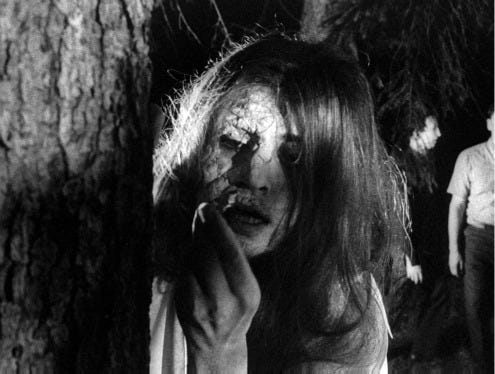Night of the Living Dead (1968)

"Night of the Living Dead" became a seminal film without being a particularly good one. I've never been a fan of George A. Romero's filmmaking skills — I think pretty much any UCLA or NYU film senior with a similar budget could do the same, or better — but there's no denying the incredible imagination and originality of the 1968 movie.
It essentially launched the zombie movie genre as we know it today and nudged horror movies out of creepy-but-family-friendly into adult films featuring gruesome violence and nihilistic overtones about the end of mankind, or at least a certain section of it.
Yes, there were zombie movies before 1968. But they tended to only have one or two or, at most, a handful of undead walking around, and voodoo or some other black magic usually played a role. Romero's film, which he co-wrote with John A. Russo, was the first to portray massive hordes of the creatures threatening to overtake all of humanity, with victims falling into their clutches turning into zombies themselves.
The fact that the zombies in this movie, and pretty much all subsequent zombie flicks, were cannibals added to the cloud of paranoia that hangs over all of the undead oeuvre. It's notable that it's usually some technological man-made disaster that causes the dead to rise — nuclear waste, scientific experiments or, in this film, radiation brought back from space by an American satellite — which adds a layer of parable to the proceedings: Humanity brought this on itself.
It's the Icarus tale, with brain-munching.
This combination of the scientific and the religious, end times brought about by mankind's folly, is a double dose of misanthropy.
It's interesting to note that the word "zombie" does not appear anywhere in the movie. The walking dead are referred to as "ghouls" in the newscasts or official pronouncements of government officials, or more commonly as just "those things" by the people being stalked by them.
"Night" also started a commonality of the genre that has become a cliche: The small band of survivors holing up somewhere to wait out the attack. Almost invariably, resources run low or they decide they'd rather die fighting than cooped up, so some plan is hatched to escape, leading to the death of most of the cast.
The selfish guy who thinks of himself first is epitomized by Harry Cooper (Karl Hardman), a middle-aged white collar guy (he wears a shirt and tie throughout the entire ordeal) who wants to hide in the basement of the lonely farmhouse where all the major characters converge. We quickly sense that power is what Cooper craves more than security, and he resents the fact that Ben (Duane Jones) runs the show. "You can be boss downstairs, but up here I'm the boss!" Ben warns.
Much hay has been made of the fact that the main character is African-American, but Romero has insisted that Jones simply gave the best audition. The rest of the cast is all white, but no mention of Ben's race, implicit or otherwise, is made. Even a potentially racially charged bit where he knocks the hysterical white girl Barbra (Judity O'Dea) out cold is depicted as the harsh but sensible action of a guy who keeps his head screwed on straight in a crisis.
In 1968, the fact a movie would present a black hero without comment is notable in of itself.
The creature effects range from non-existent to decent. There are a few close-up "money" shots of a gruesome zombie doing something especially gross — swallowing a live insect or feasting on pig's innards doubling as human ones. The make-up effects are relatively crude, looking like their faces have been slathered in plaster that is now cracking and flaking off. Considering the film's budget — a little more than $100,000, peanuts even 40-plus years ago — it's not terrible.
But at least in the early going, the zombies look like regular people stumbling around as if from a bad hangover. The first encounter, between Barbra and her brother Johnny with a ghoul in the cemetery, is punctuated by Johnny making fun of him for his strange walk. Later, many of the supposedly recent corpses look incongruously well-fed, and there's even two brief shots of a nude female zombie.
This always brings up ruminations about how the zombies keep multiplying. If they're eating their victims, what's left to rise up again and become new zombies? You'd at least expect the undead to be a lot more torn up — missing limbs, disemboweled, etc.
The acting, other than Jones, is not particularly good and occasionally amateurish. It's not surprising that many of the cast members never appeared in another movie, or just one or two more. Keith Wayne and Judith Ridley, as a hippie-ish young couple, list this film as their sole credit. The same for Kyra Schon, who had a small but memorable role as Harry Cooper's daughter, who rises as a zombie and kills her mother (Marilyn Eastman) with a garden spade. (This sequence, clearly inspired by the "Psycho" shower scene, is actually one of Romero's best.)
Zombies have experienced a pop-culture resurgence in recent years, and even spawned a tongue-in-cheek new literary genre — "Pride and Prejudice and Zombies," which is poised to become its own movie. And really, it all traces back to this 1968 film. It may have been a low-rent B-movie of questionable technical accomplishment, but its influence is deep and enduring.
4 Yaps



